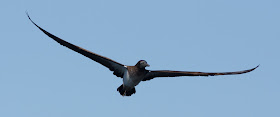I left off with the Western Diamond-backed Rattlesnake on Harshaw Canyon Road and now to continue on with our final 2 stops on Saturday before retiring to our motel in Nogales. Kelly Rishor accompanied us on to the Paton House, which is a very well known spot to stop and enjoy the various birds that pass through here. It is probably best known for being the most reliable place in the United States for finding the Violet-crowned Hummingbird. Plus it also receives many rare and scare birds from time to time. My good friend Larry Morgan is the current caretaker of this place and when Tommy, Muriel, Kelly and myself arrived he was quick to tell us that they had just seen a male Painted Bunting in the yard. This was actually another one of our target birds, but we were planning on travelling to Kino Springs to try to find this bird as it had been reported at Kino Springs for several days. Larry suggested that we go out to the road and go down the wash which was behind his feeding area. So away we went and we quickly discovered an area with running water where several birds were bathing and drinking. Tommy was the first to spy the bird in the reeds near the stream bed and shortly thereafter it made its appearance at the water to bathe. I definitely came away with very poor photos of this bird, but now I have to try to find more. This bird is not very common in Arizona and it breeds in Texas and the deep south, but every year a few of these turn up in Arizona as they start migrating south. Since it was a new life bird for me, I at least got a shot of it that helps to identify it. Has to be one of the most colorful birds to be found in the US. And as Tommy was processing his photos, he also discovered that there was a female Painted Bunting at the same time. So the less colorful bird in the background is the female.
Painted Buntings, male in front and female in the rear
Did manage to get a couple other photos of some of the various birds that were bathing in this stream of water. Even these photos left a little to be desired.
Lesser Goldfinch
Yellow Warbler
And we can't forget a photo of our wonderful host that advised us of the Painted Bunting being around, Mr Larry Morgan. Always a pleasure to stop and visit this place in the town of Patagonia. You will be glad you stopped by and even happier if Larry is at home and you get to meet him.
Larry Morgan
From Paton's, Tommy, Muriel, and I continued on to Kino Springs and Kelly headed back home to Tucson. We wanted to see if we could find the male Painted Bunting at Kino Springs as well that had been reported by several others. We did manage to find it, but it was very secretive and photos were out of the question. We did find other birds there including an Indigo Bunting which gave us 4 species of Buntings on this trip. We also discovered a family of Tropical Kingbirds and found parents still feeding some recently fledged young.
Tropical Kingbird, fledgling
Tommy and Muriel, AZ is not all desert and sand!
To finish out this post, I did manage to capture a few photos of some dragonflies while we were at Patagonia Lake earlier in the morning. Such fascinating insects and some are very colorful as well.
Blue Dasher, male
Mexican Amberwing, female
Widow Skimmer
Finally after a full day of birding we headed to Nogales to get some rest for the night and start another day of birding on Sunday.



































.jpg)















